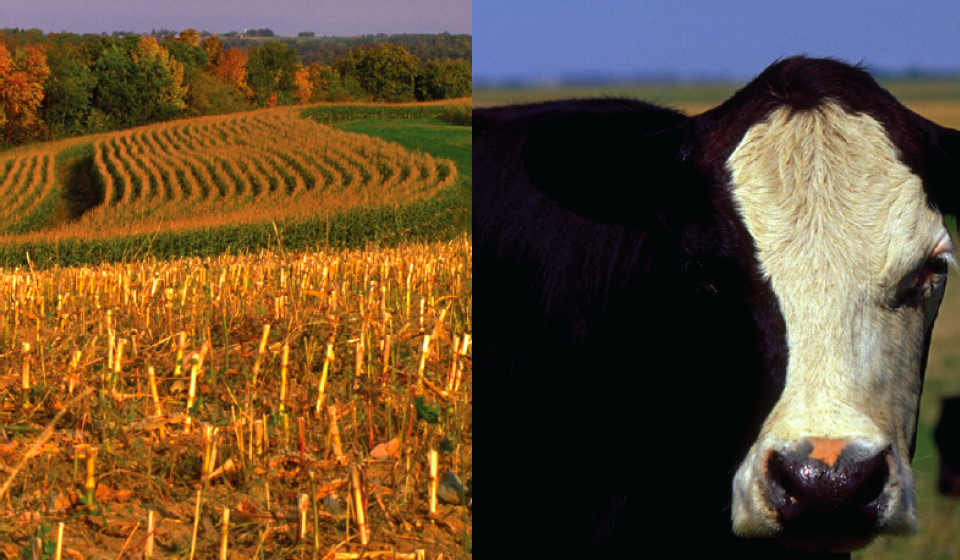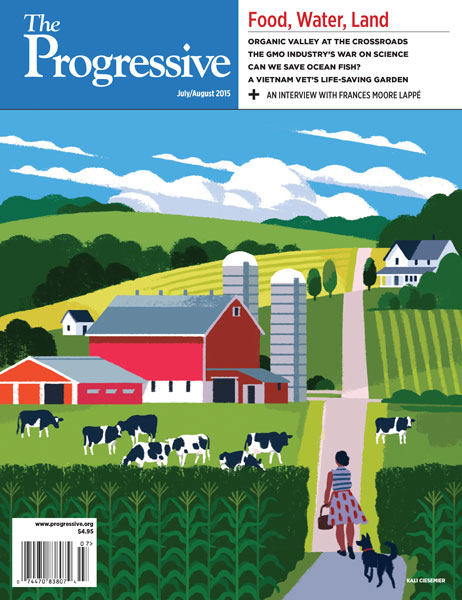President Obama’s recent Africa tour could be of great significance.
Organic Valley at the Crossroads

- Marc Eisen
In early 1988, American farming was reaching a turning point. A small group of southwestern Wisconsin farmers—an improbable mix of back-to-the-land homesteaders (hippies!) and salt-of-the-earth family farmers—banded together to form a co-op to sell organic vegetables. Desperation does that.
The 1980s were hellaciously bad times for farmers. It was the old sad story of American agriculture. Commodity prices had crashed due to oversupply and the pricing stranglehold of processors. These insurgents, whose dreams of earth-friendly farming were tempered by barnyard pragmatism, asked: What if farmers could set their own prices? What if they could sell organic farm products at a premium? What if they could step away from the chemical herbicides and fertilizers—the “inputs,” in ag business lingo—that drove up their costs, perversely depleted soil quality, and just maybe killed them with cancer?
Last year, organic food sales in the U.S. totaled nearly $36 billion. More than half of American households are customers. That western Wisconsin co-op, which markets under the name Organic Valley, is the largest organic farmer cooperative in North America.
Organic Valley was born in the state’s “Driftless Area,” an unglaciated terrain of hills and valleys where generations of families raised dairy cattle and sowed vegetables. Overlooked and far from any big city, these little farms—many milking fewer than 50 cows—seemed as outdated as a farmer’s outhouse. Back then, the idea of organic farming was radical.
This was a time, remember, when “farming” was speedily giving way to “agribusiness.” Farmers were being exhorted to plant corn and soybeans from “fence row to fence row.” The economic imperative, sounded by all the experts, was seemingly incontrovertible: “Get big or get out!”
These farm rebels didn’t want to get big. They wanted to change the game. They did, beginning with a group of fifty-seven farmers. Now, twenty-seven years later, their co-op—CROPP, for the “Cooperative Regions of Organic Producer Pools”—has approximately 1,800 farmers, including members in Canada and even one in Australia. In April, co-op members met in La Crosse, Wisconsin, to celebrate a prosperous 2014. “Organic Valley Grapples With Positive Problem of Too Much Success,” the local paper declared in a headline.
Sales last year hit $972 million, a nearly 5 percent increase from a financially rocky 2013. Net profits were up too, and the co-op’s dairy farmers, who account for 80 percent of the revenue, got the highest pay hike in the co-op’s history. “Our biggest problem is our success,” CEO George Siemon told reporters.
Surging consumer demand for organics has created supply shortages for dairy products, and immense opportunities for profit. That has attracted some of the nation’s largest American food corporations to step up an already sizable investment in organics. These aren’t people motivated by protecting the environment, says David Kaseno of the National Farmers Organization. They are “people who think: ‘Hey we can make a lot of money in organic milk.’”
The $46 billion merger of Kraft Foods Group and the H.J. Heinz Co. in March will prompt its rivals to bulk up by buying fast-growing organic food labels, both The New York Times and Bloomberg News predicted. The food giants already produce a stunning 70 percent of the items stocked in a typical co-op grocery, says Philip Howard,a Michigan State University professor who tracks corporate consolidation in the organic world.
For organic industry observers, this poses stark questions for Organic Valley: Is it smart enough and big enough to compete with the corporate giants? Will it yield to the temptation to compromise organic standards to maintain market share? More to the point, will it hold on to its all-important dairy members, who have been abandoning the co-op for the significantly better pay offered by some Organic Valley competitors?
This is the paradox of Organic Valley: At a moment of great success, it faces something of an existential threat.
In April, Michael Linsmeier, a plainly dressed dairy farmer from Reedsville, Wisconsin, is standing alone drinking a beer at the pre-dinner reception of Organic Valley’s annual dinner at the decidedly unglamorous La Crosse, Wisconsin, convention center. I walk up, and he starts telling me about milking 150 cows on a family farm south of Green Bay that dates to his grandfather in the 1920s. The transition to organic farming a decade earlier proved to be a lifesaver. The price of conventional milk had crashed in 2004, prompting one of those periodic spasms of despair and forced sales in farm country.
“We weren’t going to let our kids farm at that point,” says his wife Linda, who joined us. “We were going to sell out so they couldn’t farm. Now they’re probably going to take the farm over.”
Michael praises the co-op’s performance, though he says profits still aren’t great. But the stable price the farm receives each month affords it security against the gyrating price of conventional milk.
“I see a promising future,” says Michael.
This is a typical story in the organic farming world. And so are Mike and Linda’s unnerving words on how their fear of cancer, more than anything else, prompted their shift to organic. Mike’s dad, brother and sister had all died of it, his siblings by age 40. Had the routine spraying of herbicides and pesticides in conventional farming contributed to their death? He wonders about that and whether the hours he spent as a young man digging rocks out by hand in spray-ridden cornfields exposed him to cancer-causing chemicals.
Later, during the dinner, I sit next to George Teague, a soft-spoken dairy farmer from North Carolina’s Piedmont region. Same story. He hated spraying when he farmed conventionally, but no one else would do it. “When you wake up coughing at night, you know your body is trying to tell you something,” he says.
His Reedy Fork Farm—500 acres, 80 cows—went organic in 2007, and that changed everything. The old regimen served to max out production. Cows were only milked four or five years before they were worn out and slaughtered. Now Teague has cows 12- and 13-years old still being milked.
“A lot of that comes from grazing and being out on grass,” he explains. “We’re not pushing them as hard. Now it’s more about the health of the animal and of the farm in general.”

The promise of a traditional farm life sustained by organic’s premium revenue stream has proved especially attractive to religiously minded Amish and Mennonite family farms. These farmers now make up 44 percent of Organic Valley’s membership and have proven crucial in offsetting the loss of dairy members fed up with the pricing system.
“Dairy farming is the traditional way that Amish are involved in agriculture,” says Amish-life chronicler Erik Wesner. “It’s not just a way of making a living, it’s a vocation.”
Ernest Martin, a Mennonite who farms 150 acres with his nine children near Shiloh, Ohio, says organic farming is a good fit for his brethren. “Those of us who embraced organic farming were already involved in rotational grazing. Going organic was just the next step.”
Mennonites, he explains, own their own farms, but frequently make decisions as a group based on community needs. “That parallels Organic Valley really well,” he says. “Decisions aren’t made just around one farm but around what is best for the whole organic community.”
Long ago, the late John Kinsman, founder of Family Farm Defenders, a Wisconsin-based nonprofit that advocates for a “farmer-controlled and consumer-oriented food and fiber system,” identified the power of the organic movement. Ordinary people were putting their dollars where their beliefs were, creating a market for packaged foods not dosed with additives, milk not produced by cows shot up with growth stimulants, cereals not made from genetically modified grains. And they could support family farmers like Kinsman.
Citizen pressure led Congress to pass the Organic Foods Production Act in 1990, which set the framework for national standards for “organic” farmland, food, and permissible ingredients. A 12-year struggle ensued over the particulars, including the timetable for transitioning land (three years) and livestock (one year) from conventional to organic status. Organic stalwarts like Family Farm Defenders and the Cornucopia Institute have long complained that the standards have been watered down—particularly grazing requirements—to allow vast factory farms to gain the valuable organic imprimatur.
Still, Organic Valley was able to capitalize on a market it helped create. Under Siemon’s leadership, the co-op broke out of its Midwest confines by establishing organic dairy pools up and down the East and West coasts and in Texas to serve those vast markets. To bolster membership, the co-op even began subsidizing conventional farms transitioning to organic.
“Organic Valley promoted the whole organic movement, not just its own milk,” says Kaseno, whose National Farmers Organization was an early Organic Valley ally. “They invested a lot of money growing the organic industry so it’s respected by consumers, processors and farmers. They built the industry.”
While co-ops are common in agriculture, most deal with processing, marketing or joint purchases of farm supplies. Only a few produce food under their own names. Organic Valley is by far the nation’s largest co-op devoted to organic products. Other organic co-ops tend to be small regional operators who’ve carved out high-pay, low-overhead markets.
Today, Organic Valley sells milk, cheese, butter, produce, eggs, and even an organic energy drink under its own brand name. Outlets include Walmart, Publix and 7-11. It also provides milk for store brands and as ingredients in processed foods. This makes for a big-time operation with 800 employees headquartered in tiny La Farge (population: 757) and Cashton (population: 1,092) in the postcard beautiful Driftless Area.
But the very size of the co-op’s infrastructure has become an issue for critics. One organic farmer says he “nearly ran off the road” when he drove by Organic Valley’s new barn-inspired office building in Cashton. (Four hundred employees may eventually work there.) “Guess OV feels lots of staff and fancy offices trump farmers,” he writes in an email.
Historically, farmer co-ops get in trouble when the cost of maintating a large operation begins to cut into profits for individual farmers.
Organic Valley is drawing fire from critics who say its “pay-price” for dairy farmers is just not high enough, given the demand for organic milk.
“The competition is flat-out offering more money to recruit its farmers,” says Pete Hardin, editor of The Milkweed, a dairy monthly. “The co-op has had some very tough sledding, and it’s probably going to get tougher.
Even a $1 difference in the pay-price for a hundred-pounds of organic milk—say $32 versus $33—will cost the average Wisconsin organic dairy farmer about $1,700 a month, says central Wisconsin dairyman Jim Goodman. Double that to $3,400 lost in a month if it’s $2. Goodman ships most of his organic milk to a cheese plant in 28 u July/August 2015
Plain, Wisconsin. “I’ve never been tempted to switch to Organic Valley because they seem to have the lowest pay-price for organic of all the buyers,” he says. “They don’t treat their farmers as well as they should.”
He gets no argument from Karl Hanson, who milks 60 cows and raises 50 heifers on 300 acres in central Minnesota. Hanson is quitting the Organic Valley co-op after ten years for a smaller, better-paying co-op. He describes the situation in a phone interview. The pain is evident in his voice.
“If you get up in the morning and go to the barn, you ought to be getting ahead,” he says. But Organic Valley’s pay-price was not keeping up with rising costs for organic corn and hay. “We couldn’t do that anymore. We were spinning our wheels.”
His first four years or so with Organic Valley were great, Hanson says. He couldn’t imagine ever leaving. But then came the co-op’s decision to become a national brand: “It seemed like getting bigger was the priority, not delivering the profit margin to the farmers.” As he sees it, the cost of running the co-op “is eating up farm profits.” By dropping Organic Valley, Hanson expects to add $50,000 to $60,000 a year in revenue.
In 2008, the Cornucopia Institute revealed that the co-op had been quietly buying organic milk from what Cornucopia regarded as a factory farm. The institute’s Mark Kastel saw it as a betrayal of Organic Valley’s founding principles. The co-op argued that it was a temporary measure to keep the critical Texas milk pool functioning and thus protect the market for two smaller Texas organic dairy farms.
“We did that in the context of our mission,” says Siemon. Seven years later, the dispute is still a sore spot.
Other flashpoints have involved the co-op barring its members from dealing in raw milk (even though it’s legal in some states) and supporting so-called factory farms in their push to loosen the critical organic rules requiring pasture access for cattle.
“I think they’re getting a little complacent,” says John Peck, executive director of Family Farm Defenders. “We want Organic Valley to be a leader and not just a follower.” Kastel makes a similar point, saying: “Organic Valley is 90 percent good. What’s so frustrating is that they’re competing against companies that are highly unethical. They shouldn’t be cutting corners when they don’t have to.”

I brought these concerns up with Emily and Tim Zweber, Organic Valley’s young farmers of the year. We sat at their table before the annual dinner in April, their three kids (all under the age of 8) the picture of politeness as the grownups talked. With Tim’s parents, the Zwebers milk 95 cows on 249 rolling acres just south of the Twin Cities. It’s a fourth-generation family farm with a fifth generation in the wings.
Is Organic Valley not living up to its ideals?
“There’s a lot of grey in our industry,” Emily, thirty-three, says after a measured pause. “We have to look at the big picture: We’re creating a food supply that is safe and environmentally friendly.”
“You can’t cookie-cutter it,” says Tim, thirty-two.
“There’s not a black or white answer,” Emily agrees. “We want to make it so family farms can thrive.”
The Zwebers are a testament to the lifeline that organic extends to family farms. Tim worked as a furniture maker and auto mechanic before deciding to farm full-time.
Emily had a degree in agriculture economics. (They met as 4-H members exhibiting chickens.) When they crunched the numbers, they knew there was no way that Tim’s parents’ farm could support two families. But going organic, with its premium milk price—well, that was different. “It’s because of Organic Valley we can do what we’re doing,” Emily says.
For his part, Siemon says in an email that the co-op is “very competitive in pay price,” after a recent adjustment. He also suggested that critics, in a comment seemingly aimed at Cornucopia and Family Farm Defenders, don’t want to see organic scale up because they “have an attitude that big is bad.”
Organic is longer the quaint cottage industry of your Luddite grandparents. Forget their hockey-puck granola cookies. Forget their handmade yogurt. Forget the bruised apples in the dirty bin at the tiny grocery in the sketchy neighborhood near campus. Organics is big business now. National organic standards and consumer demand have tilted the dynamic. Most popular organic product lines, while still trading on their righteous countercultural origins, have been engulfed and devoured by Wall Street.
Consider that General Mills paid $810 million in late 2014 for Annie’s, whose organic mac and cheese products constituted a third of my older daughter’s adolescent diet. It already owned the Muir Glen and Cascadian Farm labels. WhiteWave has Horizon milk and Silk soymilk. Kellogg owns Kashi and Bear Naked. Hain Celestial has Health Valley and Walnut Acres. Pepsi has Naked Juice. Coke has Odwalla and Honest Tea. Nestle has Sweet Leaf Tea. Danone has Stonyfield. The list goes on.
Philip Howard has devised an iconic chart that tracks the octopus-like corporate ownership of organic brands. He notes that ownership is sometimes unacknowledged. Cascadian Farm and Muir Glen products, for example, don’t carry the General Mills name, but the label of its Small Planet Foods division. This can be a problem for progressive-minded consumers.
“People may be unknowingly contributing to the defeat of anti-GMO campaigns by buying Cascadian Farm products,” Howard says, explaining that General Mills funds efforts to defeat those initiatives.
Independent brands with long-established brand recognition are still around. Eden Food, Clif Bar, Bob’s Red Mill and other familiar names can be found on grocery shelves. But the competition is fierce. “I’ve talked to a lot of these CEO’s, and they tell me if they were starting out today they couldn’t make it,” says Howard.
As the market for organics continues to grow, it becomes ever more difficult for the little guys to compete against multinational corporations. The latter have far bigger marketing budgets and distribution networks and, perhaps more important, access to venture capital to buy up promising organic brands and to sign up organic dairy farmers.
Bob Parsons, a farm economist for the University of Vermont, says the organic market has been a lifesaver for family farms. He notes that about one in five of Vermont’s farms are organic, averaging sixty-five to seventy cows. “Going from conventional to organic gave them an extra ten to fifteen years of life,” he says. But profitability has been declining. Today, “the question is whether these small organic farms can last another ten years.” He doesn’t sound optimistic.
This is the tough economic environment that Organic Valley faces—challenges in the barnyard and challenges in the grocery aisle.
CEO Siemon, a blue jeans kind of guy with longish hair, is one the “back to the land” settlers turned farmer who helped launch the co-op. When I interviewed him this spring, he was the picture of confidence.
He talked about how a major fire at the headquarters in 2013 had disrupted the co-op operation, and how an unexpected shift from surplus to shortage in milk that year had added to the stress. Still, the co-op had doubled its business in the space of five years to become a billion-dollar-a-year enterprise. “Whenever you do that, you have some catch-up to do” on operational matters, he says.
I ask Siemon if the co-op is big enough to battle the multinationals for customers.
“You can never say, ‘We’re doing the right thing so we’ll survive,’” he quickly replies. “You have to survive by being good at business. Right now, I feel very comfortable about our ability to survive in the big leagues.”
Click here to read an more on Marc Eisen's conversation with Organic Valley CEO George Siemon.
Section:
- From the Magazine
Topics:
- Corporations
- Food and Agriculture
More
- Subscribe
- Featured Video
- Recent Stories
- Recent Comments
- Poetry



As the nascent #BlackLivesMatter movement seeks reform of a criminal justice system that preys upon communities of...

The test-and-punish model marks a cultural shift away from the War on Poverty, and that should be a red flag for...
-
I do not buy any organic
-
Few read newspapers anymore,
-
Anyone that actually still
By Wendell Berry
Manifesto: The Mad Farmer Liberation Front
Love the quick profit, the annual raise, vacation with pay. Want more of everything ready made. Be afraid to know your neighbors and to die. And you will have a window in your head. Not even your future will be a mystery any more. Your mind will be punched in a card and shut away in a little drawer. When they want you to buy something they will call you. When they want you to die for profit they will let you know. So, friends, every day do something that won’t compute. Love the Lord. Love the world. Work for nothing. Take all that you have and be poor. Love someone who does not deserve it. Denounce the government and embrace the flag. Hope to live in that free republic for which it stands. Give your approval to all you cannot understand. Praise ignorance, for what man has not encountered he has not destroyed. Ask the questions that have no answers. Invest in the millennium. Plant sequoias. Say that your main crop is the forest that you did not plant, that you will not live to harvest. Say that the leaves are harvested when they have rotted into the mold. Call that profit. Prophesy such returns. Put your faith in the two inches of humus that will build under the trees every thousand years. Listen to carrion—put your ear close, and hear the faint chattering of the songs that are to come. Expect the end of the world. Laugh. Laughter is immeasurable. Be joyful though you have considered all the facts. So long as women do not go cheap for power, please women more than men. Ask yourself: Will this satisfy a woman satisfied to bear a child? Will this disturb the sleep of a woman near to giving birth? Go with your love to the fields. Lie easy in the shade. Rest your head in her lap. Swear allegiance to what is nighest your thoughts. As soon as the generals and the politicos can predict the motions of your mind, lose it. Leave it as a sign to mark the false trail, the way you didn’t go. Be like the fox who makes more tracks than necessary, some in the wrong direction. Practice resurrection.
Wendell Berry is a poet, farmer, and environmentalist in Kentucky. This poem, first published in 1973, is reprinted by permission of the author and appears in his “New Collected Poems” (Counterpoint).















Comments
I do not buy any organic
Add new comment